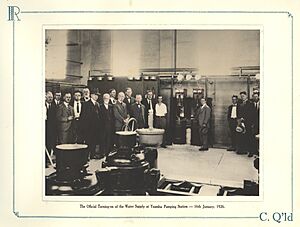Yaamba facts for kids
Quick facts for kids YaambaQueensland |
|||||||||||||||
|---|---|---|---|---|---|---|---|---|---|---|---|---|---|---|---|

Worker at the controls at the Yaamba pumping station, 1935
|
|||||||||||||||
| Population | 51 (2021 census) | ||||||||||||||
| • Density | 0.772/km2 (2.00/sq mi) | ||||||||||||||
| Postcode(s) | 4704 | ||||||||||||||
| Area | 66.1 km2 (25.5 sq mi) | ||||||||||||||
| Time zone | AEST (UTC+10:00) | ||||||||||||||
| Location |
|
||||||||||||||
| LGA(s) | Shire of Livingstone | ||||||||||||||
| State electorate(s) | Mirani | ||||||||||||||
| Federal Division(s) | Capricornia | ||||||||||||||
|
|||||||||||||||
Yaamba is a small town and area in Queensland, Australia. It's located in the Livingstone Shire. In 2021, only 51 people lived in Yaamba.
Contents
Where is Yaamba?
Yaamba is located next to the Fitzroy River in the south. Alligator Creek, a smaller stream, runs along its eastern side. The main part of the town is found in the southern area, close to the river.
The Bruce Highway passes through Yaamba. When it enters from the east, it's called Yaamba Road. After passing the town, it becomes Kunwarara Road as it heads west.
The North Coast railway line also goes through Yaamba. It runs parallel to the highway. The town has its own train stop called Yaamba railway station.
Most of the land around Yaamba is used for raising animals. There are two groups of houses in the town. One is near the highway and railway station, and the other is closer to the river.
A Look Back in Time
The Name of Yaamba
The area where Yaamba is located belongs to the Darumbal people. Their language region covers a large area, including the city of Rockhampton.
The name "Yaamba" comes from a large farm, or "pastoral run," that started in the 1860s. It's believed to be an Aboriginal word. It means "main camping ground."
People started buying land in Yaamba to build homes in November 1860.
The Story of Big Ben
In 1872, a very large salt water crocodile named Big Ben was found dying in Alligator Creek. This crocodile was huge, measuring over 22 feet long! Local Aboriginal people had many stories about Big Ben. They celebrated when it died.
Yaamba State School
Yaamba had its own school called Yaamba State School. It first opened in 1867. However, it closed its doors on April 12, 1940.
The Yaamba Pumping Station
On January 16, 1926, the Yaamba pumping station officially opened. Important people like the Mayor of Rockhampton and the Minister of Railways were there.
The main reason for this pumping station was to give the growing city of Rockhampton fresh water. The part of the Fitzroy River closer to Rockhampton had salty water from the ocean. So, the pumping station at Yaamba took fresh water from further up the river.
The water was then sent through pipes to a cleaning plant at Mount Charlton. After being cleaned, it was sent to homes in Rockhampton. This project was very expensive for its time, costing £400,000.
After World War II, Rockhampton kept growing. There were also times of drought, which meant less water. It became clear that Yaamba couldn't supply enough water anymore. Also, the long pipes from Yaamba often got blocked with dirt, which was hard to fix.
Because of these problems, a new plan was made. In 1969, a special wall called a barrage was built across the Fitzroy River in Rockhampton. This wall stopped the salty water from coming up the river. A new pumping station and water treatment plant were built closer to Rockhampton. These new facilities opened in 1971.
Today, the Yaamba pumping station is no longer used.
People in Yaamba
In 2016, there were 62 people living in Yaamba. By 2021, the population had changed slightly to 51 people.
Schools Near Yaamba
Yaamba itself does not have any schools. The closest primary school for younger students is Milman State School. It's in the nearby area of Milman. For older students, the nearest high school is Glenmore State High School. It's located in Kawana, which is part of Rockhampton.
Other Places in Yaamba
Yaamba has a cemetery where people are buried. It's called Yaamba Cemetery. The local council, Livingstone Shire Council, takes care of it.



